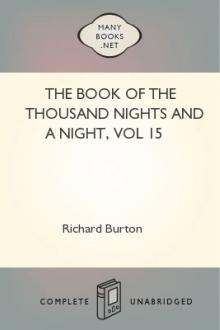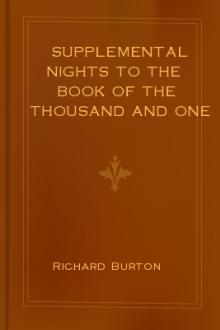The Book of the Thousand Nights and a Night, vol 15 by Sir Richard Francis Burton (classic romance novels .TXT) 📖

- Author: Sir Richard Francis Burton
- Performer: -
Book online «The Book of the Thousand Nights and a Night, vol 15 by Sir Richard Francis Burton (classic romance novels .TXT) 📖». Author Sir Richard Francis Burton
[FN#548] Meaning only that the babe was perfectly beautiful.
[FN#549] In order that the cord might not be subject to the evil eye or fall into the hand of a foe who would use it magically to injure the babe. The navel-string has few superstitions in England. The lower classes mostly place over the wound a bit of cloth wherein a hole has been burned, supposing that the carbon will heal the cut, and make it fast to the babe by a “binder” or swathe round the body, as a preventative to “pot-belly.” But throughout the East there are more observances. In India, on the birth of the babe, the midwife demands something shining, as a rupee or piece of silver, and having touched the navel-string therewith she divides it and appropriates the glittering substance, under the pretence that the absence of the illuminating power of some such sparkling object would prevent her seeing to operate. The knife with which the umbilical cord has been cut is not used for common purposes but is left beside the puerpera until the “Chilla” (fortieth day), when “Kajjal”
(lamp-black), used by way of Kohl, is collected on it and applied to the child’s eyelids. Whenever the babe is bathed or taken out of the house the knife must be carried along with it; and when they are brought in again the instrument is deposited in its former place near the mother. Lastly, on the “Chilla”-day they must slaughter with the same blade a cock or a sheep (Herklots, chapt. i. sec. 3). Equally quaint is the treatment of the navel-string in Egypt; but Lane (M.E.) is too modest to give details.
[FN#550] In text “Sarsarah,” a clerical error for “Akhaza(?) surratan.” See MS. vol. vi. p. 197, line 9. [I read “sarra Surrah (Surratan)” = he tied up a purse.—ST.]
[FN#551] In the text “on account of the dust-cloud” which, we were just told, had cleared away [The translator seems to have overlooked the “k�na” before “kad d�khala-hu al-Ra’b,” which gives to the verb the force of a pluperfect: “and fear had entered into him at the sight of the dust-cloud.”—ST.]
[FN#552] i.e. his daughter, of whom he afterwards speaks in the plur.
[FN#553] These concealments are inevitable in ancient tale and modern novel, and it need hardly be said that upon the nice conduct of them depends all the interest of the work. How careful the second-rate author is to spoil his plot by giving a needless “pregustation” of his purpose, I need hardly say.
[FN#554] The mysteries of the marriage-night are touched with a light hand because the bride had already lost her virginity.
[FN#555] In text “Ab�yah,” a Fellah vulgarism for Ab� which latter form occurs a few lines lower down.
[FN#556] In text “Wa-Saw�bi ‘hu (As�bi ‘a-hu?) f� hanaki-h:” this is explained in MS. p. 216: “Biyarza’u f� As�b� hi.” [Dozy, Suppl. i. 815, gives “Saw�bi’” as an irregular pl. of “Asba’”
quoting from Bresl. ed. iii. 381, 9.] I would rather say it is a regularly formed broken plural of a singular “S�bi’” = the pointing one, i.e. index, now commonly called “Sabb�bah” the reviler, where the same idea of pointing at with contempt seems to prevail, and “Sh�hid” = the witnessing, because it is raised in giving testimony. In the plural it would be naturally generalised to “finger,” and in point of fact, the sing. “S�bi’”
is used nowadays in this sense in Egypt along with the other popular form of “Sub�’.”
[FN#557] I write “Cafilah” and not “Cafila” with the unjustifiable suppression of the final “h” which is always made sensible in the pure pronunciation of the Badawi. The malpractice has found favour chiefly through the advocacy of Dr. Redhouse, an eminent Turkish scholar whose judgments must be received with great caution; and I would quote on this subject the admirable remarks of my late lamented friend Dr. G. P. Badger in “The Academy” of July 2, 1887. “Another noticeable default in the same category is that, like Sale, Mr. Wherry frequently omits the terminal �h’ in his transliteration of Arabic. Thus he writes Sura, Am�na, F�tima, Mad�na, Tah�ma; yet, inconsistently enough, he gives the �h’ in Allah, Khadijah, Kaabah, Makkah, and many other words. This point deserves special notice, owing to Dr.
Redhouse’s letter, published in �The Academy’ of November 22
last, in which he denounces as �a very common European error’ the addition of the �h’ or �final aspirate,’ in the English transliteration of many Arabic words. Hence, as I read the eminent Orientalist’s criticism, when that aspirate is not sounded in pronunciation he omits it, writing “F&amacron;tima,”
not Fatimah, lest, as I presume, the unwary reader may aspirate the �h.’ But in our Bibles we find such names as Sarah, Hannah, Judah, Beulah, Moriah, Jehovah, in the enunciation of which no one thinks of sounding the last letter as an aspirate. I quite agree with Dr. Redhouse that in the construct case the final h assumes the sound of t, as in Fatimatu bint-Muhammed; yet that does not strike me as a valid reason for eliding the final h, which among other uses, is indicative of the feminine gender, as in F�timah, Khad�jah, Am�nah, etc.; also of the nomina vicis, of many abstract nouns, nouns of multitude and of quality, as well as of adjectives of intensiveness, all which important indications would be lost by dropping the final h. And further unless the vowel a, left after the elision of that letter, be furnished with some etymological mark of distinction, there would be great risk of its being confounded with the �, formative of the singular of many verbal nouns, such as bin�, saf�, jal�; with the masculine plurals ending in the same letters, such as hukam�, �ghniy�, k�far�; and with the feminine plurals of many adjectives, such as k�bra, s�ghra, h�sna, etc. Dr. Redhouse says that �many eminent Arabists avoid such errors’—a remark which rather surprises me, since Pocock, Lane and Palmer, and Fresnel and Perron among French Orientalists, as also Burton, all retain the final aspirate h, the latter taking special care to distinguish, by some adequate, diacritical sign, those substantive and adjective forms with which words ending in the final aspirate h might otherwise be confounded.”
[FN#558] In the text, “Wa s�ba’l-d�r wa Zaujatu-hu mutawass�y�n bi-h�.” [I cannot explain to myself the plural “Mutawass�n”
unless by supposing that the preceding “S�b al-D�r” is another blunder of the scribe for “S�hibu ‘l-D�r” when the meaning would be: “and the master of the house and his wife took charge of her (the nurse) during the days of suckling.” —ST.]
[FN#559] In text “S�r� yar�sh�-hu wa yatawassu.”
[FN#560] [In the text “Fik�” the popular form of the present day “Fik�h,” properly “learned in the law” (LL.D. as we would say), but now the usual term for “schoolmaster.”—ST.]
[FN#561] Both of which are practised by Easterns from horseback, the animal going at fullest speed. With the English saddle and its narrow stirrup-irons we can hardly prove ourselves even moderately good shots after Parthian fashion.
[FN#562] In text “Ihtim�m wa Ghullah”: I suspect that the former should be written with the major h, meaning fever.
[FN#563] See Suppl. vol. iv. p. 191.
[FN#564] i.e. tempt not Providence unless compelled so to do by necessity.
[FN#565] The youth was taking a “F�l” or omen: see vol. v. 136.
[FN#566] In text “Hasal,” for which I would read “Khasal.”
[FN#567] A wiser Sprichwort than those of France and America. It compares advantageously with the second par. of the Declaration of Independence (July 4, 1776) by the Representatives of the U.S., which declares, “these truths to be self-evident:—that all men are created equal,” etc. It is regretable that so trenchant a state-paper should begin with so gross and palpable a fallacy.
Men are not born equal, nor do they become equal before their death-days even in condition, except by artificial levelling; and in republics and limited monarchies, where all are politically equal, the greatest social inequalities ever prevail. Still falser is the shibboleth-crow of the French cock, “Libert�, Egalit�, Fraternit�,” which has borrowed its plumage from the American Bird o’ Freedom. And Douglas Jerrold neatly expressed the truth when he said,—“We all row in the same boat but not with the same sculls.”
[FN#568] Sayf Kun�z� = a talismanic scymitar: see “Kanz,” ix.
320.
[FN#569] In Arab. “Al-Kutb al-Ghauth” = lit. the pole-star of invocation for help; or simply “Al-Ghauth” is the highest degree of sanctity in the mystic fraternity of Tasawwuf. See v. 384; and Lane (A. N.) i. 232. Students who would understand these titles will consult vol. iii. chapt. 12 of The Dabist�n by Shaw and Troyer, Paris and London, 1843. By the learned studies of Dr.
Pertsch the authorship of this work of the religious eclecticism of Akbar’s reign, has been taken from the wrongful claimant and definitively assigned to the legitimate owner, Mobed Shah. (See Z. d. M. G. xvi. 224.) It is regretable that the index of the translation is worthless as its contents are valuable.
[FN#570] Arab. “Su’ub�n” = cockatrice, etc., vols. i. 172; vii.
322. Ibn Khaldun (vol. iii. 350) tells us that it was the title of a famous and fatal necklace of rubies.
[FN#571] In Ar. “Anakati-h.” [This is a very plausible conjecture of the translator for the word written in the text: “‘Anfakati-h”
= the hair between the lower lips and the chin, and then used for the chin itself.—ST.]
[FN#572] In the text “Tisht” (a basin for the ewer), which I have translated tray: these articles are often six feet in diameter.
[FN#573] A neat touch of realism: the youth is worn out by the genial labours of the night which have made the bride only the merrier and the livelier. It is usually the reverse with the first post-nuptial breakfast: the man eats heartily and the woman can hardly touch solid food. Is this not a fact according to your experience, Mesdames?
[FN#574] In text “Tazargh�t” a scribal error for “Zaghr�tah.” In Mr. Doughty (ii. 621) “Zal�gh�t” for “Zagh�rit” and the former is erroneously called a “Syrian word.” The traveller renders it by “Lullul-lullul-lullul-l�.” [Immediately before, however, the correct form “hiya tazaghritu,” she was lullilooing, had been used. The word occurs in numerous forms, differentiated by the interchange of the dental and palatal “t” and of the liquid letters “r” and “l.” Dozy gives: “Zaghrata,” “Zaghlata” and “Zalghata” for the verb, and “Zaghr�tah,” “Zaghr�tah” (both with pl. “Zagh�r�t”), “Zalgh�tah,” “Zalghatah” (both with pl.
“Zal�gh�t”), and even a plural “Zagh�l�t” for the noun.—ST.]
[FN#575] In these cases usually an exception is made of brigands, assassins and criminals condemned for felony. See Ibn Khaldun, iv. 189.
[FN#576] [In text: “biyarza’ f� As�b�-hi” (see supra p. 294).
This is, as far as I remember, the





Comments (0)